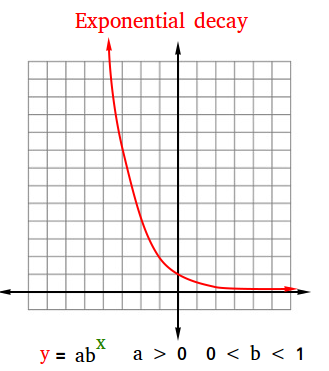Modeling exponential decay
Modeling exponential decay quickly without doing too much math computation is the goal of this lesson.
In our previous lesson about what is exponential decay we modeled the following problem shown in bold with y = 100,000(0.97)x
The population of a city was 100,000 in 1980.
Then every year, the population has decreased by 3% of a result of heavy
pollution.
Just like we did it for exponential growth, we will show that there is an easier and quicker way to get the same answer.
The only trick is to see that 100% - 3% = 97% = 0.97 instead of doing the complicated math computation in the lesson referenced above. Using the decay factor, you can just model the problem as shown below.
Let x be the number of years since 1980
Let y be the population at various time
Let a be the initial population or 100,000
Let b be the decay factor, which is 0.97
Then using y = abx, we get y =100,000(0.97)x
Other examples
The value of new car decreases exponentially. Suppose you buy a new car for 45,000 dollars. It is said that the value of a new car will decrease by 20% each year. Model the value of your car with an exponential function x years after you bought it.
y = abx
Let x be the number of years since you bought the car.
Let y be the value of the car x years after you bought it.
Let a be the initial cost of 45,000 dollars
Let b be the decay factor, which is 100% - 20% = 80% = 0.80
Then y = 45000(0.80)x
Modeling exponential decay in medicine
A 300 mg painkiller is given to a patient. How much of the medication will remain in the bloodstream after x hours if 12% of the medication disappears from the bloodstream every hour?
y = abx
Let x be the number of hours since you took the 300 mg painkiller.
Let y be the amount of painkiller left in the bloodstream after x hours.
Let a be the initial amount in the bloodstream.
Let b be the decay factor, which is 100% - 12% = 88% = 0.88
Then y = 300(0.88)x
Modeling exponential decay in radioactive substance
The half-life of a radioactive substance is the length of time it takes for one half of the substance to decay into another substance. The half-life of iodine-125 is about 59 days and it can be used to treat some forms of tumors. Suppose a patient receives a 20-mCi (millicuries, a measure of radiation) treatment. How much iodine-125 is left in the patient 177 days after?
The important thing to understand here is half-life is 59 days. It means that the substance will lose half of its original amount or decay by 50% every 59 days.
y = abx
Let x be the number of half-lives in 177 days
Let y be the amount of painkiller left in the bloodstream after 177 days
Let a be the initial amount in the bloodstream.
Let b be the decay factor, which is 100% - 50% = 50% = 0.50
Then y = 20(0.50)x
177 divided by 59 = 3. so x = three half-lives
y = 20(0.50)3
y = 20(0.125)
y = 2.5
There will be 2.5 millicuries left in the patient.
Graph of exponential decay
 Modeling exponential decay
Modeling exponential decay